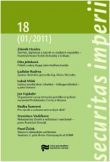Zpráva divizního generála Ing. Aloise Vicherka o událostech od československé mobilizace do 4. března 1941 Neznámý archivní dokument ve světle faktů
A report by Division General Ing. Alois Vicherek on events from the Czechoslovak mobilisation up to 4 March 1941. An unknown archive document in the light of the facts.
Author(s): Ladislav KudrnaSubject(s): Archiving, Military history, Government/Political systems, Interwar Period (1920 - 1939), WW II and following years (1940 - 1949)
Published by: Ústav pro studium totalitních režimů
Keywords: Alois Vicherek;Czechoslovakia;exile government;Edvard Beneš;
Summary/Abstract: In the spring of 1941, the Division General Ing. Alois Vicherek wrote a report, which made its way to both his superior officer, the division general Sergěj Ingr, and the man heading the Czechoslovak foreign campaign, president Edvard Beneš. This Report recorded in detail the events that had occurred since the announcement of a general Czechoslovak mobilisation on 23 September 1938 up to 4 March 1941. General Vicherek provided a new viewpoint on key events in modern Czechoslovak history. It is necessary to point out that this comes from a man who was “on the other side of the tracks” when he was working on his text. It is probably because of this that he fell into disfavour with his superiors, and this document was not preserved in the official reports of the Ministry of National Defence. This important material for Czechoslovak historiography was discovered by Mgr. Martin Juřica when he was working on his thesis about General Alois Vicherek. The Report was given to him by Vicherek’s second wife Marie Vicherková. Thanks to this, we now know that a Soviet military mission arrived on the territory of Czechoslovakia after the declaration of the mobilisation. This mission consisted of the deputy commander of the Soviet military air force Yakov Vladimirovich Smushkevich and an unknown air force colonel. The Soviet officers offered the Czechoslovak side a total of 700 aircraft, but they also demanded details about air defences, the distribution of airfields, the numbers of aircraft and squadrons. In Pardubice, one of the Soviet officers flew a Czechoslovak Avia B-534 fighter plane. With respect to the progress and outcome of the Munich Crisis, it is not apparent whether this was simply a calculated measure on the part of the Soviets, i.e. we [might] give you aircraft if you provide us with all the details about your air force. General Vicherek also did not omit the difficult situation in Cieszyn region in 1938 as well as the course of the German occupation in March. Other important information includes the General’s account of the possibility of using Czech pilots in the German civilian air force. The Luftwaffe commander, Hermann Göring himself came up with this offer. A description concerning the monetary funds of the Ministry of National Defence, which could not be saved for the resistance, is also noteworthy. There is also no lack of information on Vicherek’s extensive resistance activities in the occupied Czech lands. Understandably, the “feud” with his rival General Karel Janoušek, which was concluded to Vicherek’s detriment in Great Britain, is also not omitted. Part of the study comprises profiles of both protagonists, as well as an extensive Appendix covering the key personalities in the events of that time appearing in Vicherek’s texts.
Journal: Securitas imperii
- Issue Year: 2011
- Issue No: 18
- Page Range: 70-143
- Page Count: 74
- Language: Czech

